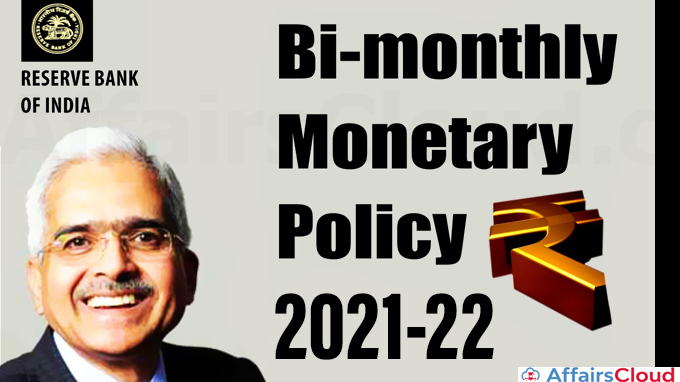 The Reserve Bank of India’s (RBI) 6-members Monetary Policy Committee (MPC) had met on 5th, 6th and 7th April 2021 and released its first bi-monthly monetary policy statement for FY22 (April 2021 – March 2022).
The Reserve Bank of India’s (RBI) 6-members Monetary Policy Committee (MPC) had met on 5th, 6th and 7th April 2021 and released its first bi-monthly monetary policy statement for FY22 (April 2021 – March 2022).
Policy Rates:
The Policy rates were kept unchanged, which are as follows:
The central bank’s decision to keep rates unchanged for the fifth consecutive time.
Category | Rate |
Policy Rates | |
| Policy Repo Rate | 4.00% |
| Reverse Repo Rate | 3.35% |
| Marginal Standing Facility (MSF) Rate | 4.25% |
| Bank Rate | 4.25% |
Reserve Ratios | |
| Cash Reserve Ratio (CRR) | 3.50% |
| Statutory Liquidity Ratio (SLR) | 18.00% |
i.MPC’s Assessments on growth and inflation:
-Growth
- The committee has projected India’s real gross domestic product (GDP) growth for FY22 at 10.5% with 26.2% in Q1; 8.3% in Q2; 5.4% in Q3; and 6.2% in Q4.
-Inflation
- CPI inflation/Retail inflation for Q4FY21 was revised to 5.0% and for the H1 FY22 was projected to be 5.2% along with 4.4 % in Q3 and 5.1% in Q4 (Factors considered: Food inflation, Taxes on petroleum products, high international commodity prices and logistics costs)
- The government retained the inflation target at 4% with the lower and upper tolerance levels of 2% and 6%, i.e. within a band of +/- 2 %, for the next five years (April 2021-March 2026).
Members of MPC:
The MPC meeting was headed by RBI Governor Shaktikanta Das the other 5 members of the committee include,
- Dr. Shashanka Bhide, Dr. Ashima Goyal, Prof. Jayanth R. Varma, Dr. Mridul K. Saggar, and Dr. Michael Debabrata Patra.
ii.MPC’s Statement on Developmental and Regulatory Policies:
-RBI extended the deadline for TLTRO on Tap Scheme
RBI has decided to extend the Targeted Long Term Repo Operations (TLTRO) on Tap Scheme by a period of six months, i.e., till September 30, 2021. Earlier the scheme was made available till March 31, 2021.
Background:
- On October 9, 2020, RBI announced the TLTRO on Tap Scheme worth Rs 1 trillion to provide liquidity support to various sectors and banks
Eligible Sectors under TLTRO on Tap Scheme:
- Initially, in October 2020 only 5 sectors are included under the scheme such as Agriculture, Agri-Infrastructure, Secured Retail, Micro, Small and Medium Enterprises (MSMEs) and Drugs, Pharmaceuticals and Healthcare.
- Later, in addition to them, Kamath Committee identified 26 stressed sectors and bank lending to NBFCs were also included under the same in the December, 2020 and February, 2021.
- The liquidity availed by banks under the TLTRO scheme is to be deployed only in corporate bonds, commercial paper, and non-convertible debentures issued by entities in these sectors.
- Investments made by banks under this facility can be classified as held to maturity (HTM) even above the 25 per cent of total investment permitted to be included in the HTM portfolio.
-RBI planned to extend SLP of ₹50,000 cr. to AIFIs
To mitigate the impact of the pandemic and to support the economic rival RBI planned to extend fresh lending of Special Liquid Facility(SLF) of Rs 50,000 crore for FY22 to All India Financial Institutions (AIFIs) such as the National Bank for Agriculture and Rural Development (NABARD), the Small Industries Development Bank of India (SIDBI), the National Housing Bank (NHB), and the EXIM Bank.
Special Liquid Facility(SLF):
- Rs 25,000 crore to NABARD to support agriculture and allied activities, the rural non-farm sector and non-banking financial companies – microfinance institutions (NBFC-MFIs)
- Rs 10,000 crore to NHB to support the housing sector. To meet the funding requirements of micro, small and medium enterprises (MSMEs) and Rs 15,000 crore to SIDBI.
Background:
- SLF of Rs 75,000 crore was provided to AIFIs during April-August 2020.
-RBI will set up a committee to help ARCs to realize their full potential
RBI will constitute a Committee to review the working of asset reconstruction companies (ARCs) in the financial sector ecosystem and to recommend suitable measures to meet the growing requirements of the financial sector.
Background:
- Securitisation and Reconstruction of Financial Assets and Enforcement of Security Interest (SARFAESI) Act in 2002, which is a regulatory guideline for Asset Reconstruction Companies (ARCs) were issued in 2003 to enable the development of this sector and to facilitate smooth functioning of ARCs.
- ARC and an asset management company (AMC) will help public sector banks (PSBs) in dealing with bad loans and stressed assets.
-RBI has extended PSL by Banks to NBFCs up to September 30, 2021
- RBI extended the classified lending of Banks to NBFCs for on-lending under the Priority Sector Lending (PSL) for 6 months i.e. up to September 30, 2021.
-RBI has increased the PSL loan limits for lending against NWRs /eNWRs to Rs 75 lakh
- RBI has enhanced the loan limits under Priority Sector Lending(PSL) for banks’ lending against Negotiable Warehouse Receipts (NWRs) / electronic Negotiable Warehouse Receipts (eNWRs) from ₹50 lakhs to ₹75 lakhs per borrower.
- Loan limit under priority sector lending to agriculture sector has been increased to Rs 60 lakh from Rs 50 lakh.
-RBI accepted the WMA recommendation to advance the WMA limit for states by 46%
RBI constituted an Advisory Committee under the Chairmanship of Shri Sudhir Shrivastava in August 2019 to review the Ways and Means Advances (WMA) limits. The committee also made some recommendation over WMA.
The recommendations that are accepted by RBI:
- An increase in the limit of WMA for all states to ₹47,010 crores, against the current limit of ₹32,225 crores (fixed in February 2016), represents an increase of about 46%.
- Continuation of the enhanced interim WMA limit of ₹ 51,560 crores for 6 months (April 1, 2021, to September 30, 2021) which was allowed by RBI during FY21 to states/UTs for COVID-19.
What is WMA?
- It is a short-term borrowing arrangement between the RBI and central and state governments. RBI as a banker to the State Governments provides WMA to the States Under Section 17(5) of RBI Act, 1934 to help them to tide over temporary mismatches in the cash flow of their receipts and payments.
-RBI announced the periodic publishing of FI Index
- RBI announced the construction and periodic publishing of the “Financial Inclusion Index” (FI Index) annually in July month (for the financial year ending previous March) to measure the extent of financial inclusion in the country.
- FI Index will be based on multiple parameters in order to reflect the broadening and deepening of financial inclusion.
Financial inclusion:
- It is the delivery of financial products and services at an affordable cost to vast sections of disadvantaged and low-income groups. Financial inclusion strives to remove the barriers that exclude people from participating in the financial sector.
-RBI extended RTGS and NEFT money transfer facilities to Non-Bank Payment System Operators
RBI extended the membership of Centralised Payment Systems (CPSs) facilities such as National Electronic Funds Transfer (NEFT) and Real-Time Gross Settlement (RTGS) to non-bank payment system operators.
- Until now, only banks were allowed to use RTGS and NEFT payments facilities.
- Now, Prepaid Payment Instrument (PPI) issuers, card networks, White label ATM operators and Trade Receivables Discounting System (TReDS) platforms which are regulated by RBI can use NEFT and RTGS modes.
-RBI has doubled the Payments bank’s deposit limit from Rs 1 lakh to Rs 2 lakhs
MPC has decided to enhance the limit of maximum balance at end of the day from ₹1 lakh to ₹2 lakh per individual customer. It was decided based on a review of performance of payments banks and with a view to encourage their efforts for financial inclusion and to expand their ability to cater to the needs of their customers, including MSMEs, small traders and merchants.
-PPIs(Mobile Wallets) account limit increased to ₹ 2 lakh from ₹ 1 lakh;Improve the Interoperability of PPIs to full-KYC
To promote optimal Utilisation of payment instruments (like cards, Mobile Wallets etc.), it is proposed to increase the limit of outstanding balance in such PPIs(Mobile Wallets) from the current level of ₹1 lakh to ₹2 lakh.
- After this, Mobile wallets like Paytm, Mobikwik can be used to withdraw cash from ATMs.Earlier, banking PPIs like the Yono app from SBI had this facility.
- The new changes will affect companies like Paytm, PhonePe, Mobikwik, and Google Pay among others.
-RBI provided relief to ECB borrowers’ unutilised proceeds
- As per the External Commercial Borrowings (ECB) framework, ECB borrowers are allowed to park ECB proceeds in term deposits with Authorised Dealer Category -I
(AD Category I) banks in India for a maximum period of 12 months. - Now RBI has made relief and allowed the ECB borrower to place their unutilised ECB proceeds which are drawn down on or before March 1, 2020, in terms of deposits in the AD Category-I banks in India for up to March 1, 2022.
- It was especially for the borrowers who couldn’t utilise the already drawn down proceeds due to lockdown and restrictions under COVID-19.
External Commercial Borrowings (ECB):
- It is a loan availed by an Indian entity from a non-resident lender with a minimum average maturity.
- The borrowing limit is about $750 million per financial year.
- The minimum average maturity period is 3/5 years.
Recent Related News:
In accordance with the internal report from the Reserve Bank of India (RBI) namely ‘Report on Currency and Finance (RCF) for the year 2020-21″ on the theme “Reviewing the Monetary Policy Framework”, India fixed the medium-term inflation target of 4% with a +/-2 % tolerance band as appropriate for the country. This is in lieu of the RBI’s flexible inflation targeting (FIT) mandate.
On March 22, 2021, the Reserve Bank of India(RBI) set up a five-member Standing External Advisory Committee (SEAC) which is headed by former RBI Deputy Governor Shyamala Gopinath, for evaluating applications for universal banks and small finance banks(SFBs). The tenure for SEAC will be for 3 years
About Reserve Bank of India (RBI):
Establishment – 1st April 1935
Headquarters – Mumbai, Maharashtra
Governor – Shaktikanta Das
Deputy Governors – Mahesh Kumar Jain, Michael Debabrata Patra, and M Rajeswar Rao (Bibhu Prasad Kanungo retired on April 2, 2021)




